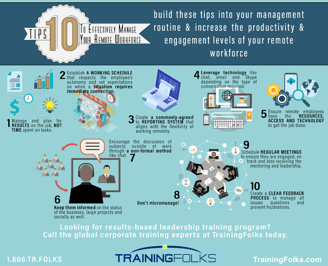Managing Remote Workforces with Strong Leaders

Along with the many changes that COVID-19 has brought into our lives, the way that we live and work has most likely been forever altered.
To increase safety, reduce risks and adhere to government regulations, many companies have shifted most of their work venues from the physical office to their workers' homes. Some have set up a hybrid model, where employees rotate and work part of the time at the office and part of the time at home.
Initially, this was viewed as a temporary solution that would continue only during the time of the pandemic. However, more and more, many leaders are seeing the cost savings that having a remote work staff can bring. Thus, they are viewing having employees work from home as a permanent measure.
How do you Develop Leaders to manage a Remote Workforce?
We can view the drastic increase in the number of employees working from home as moving from the 3rd to the 4th industrial age. This 4th industrial age focuses on the location of your company's workers. It has become much less important where workers are or the hours that they work. Rather, the essential consideration is how productive they can be.
Technically, workers can be anywhere in the world, as long as they are able to provide the quality of work their companies need and within a time-frame that the work is needed. If you are not able to shift into the mindset that a large portion of your team of employees may not sit in the same physical space that you do, you and your company may face problems.
You must deploy training that will develop leaders who can manage a remote, possibly even a more globalized, workforce, and sooner rather than later. This can be done with custom eLearning development or Virtual Instructor Led Training (vILT).
How will having a Remote Workforce Affect Leadership Development?
One important facet of this shift from the brick-and-mortar work venue to that of a remote one is that the management of these remote employees will also need to consider ways to coach team members working from home.
With these new opportunities for change in the way employees work, companies must consider developing leaders with a solid plan for effective communication, thereby creating a collaborative working environment. Also important is assuring that trust, accountability, and transparency are always at the forefront of management operations.
What exactly can managers do to help ensure the success of leading their remote workforce? Let's look at three effective ways to help as a manager of distant workers.
Communicate Often and Honestly
The need to ensure regular and sincere communication with teams is even more important when they are working from home. Employees need to know exactly what is expected from them, when specific tasks must be completed, and what the scope of their work is. There can be no room for ambiguity with communications from managers or leadership.
One way that you can make sure your remote teams receive the information they need is to have daily or weekly update call from the company CEO or other high-ranking manager. This will reassure remote employees that the information that they receive is coming from the top.
Make Remote Workers Feel Part of the Team
As a leader, you must provide frequent opportunities for remote employees to connect, share ideas, stories, and points of pride, and to know that what they do for the company is important and valued by management.
Try offering virtual social interactions, where your team members are encouraged to let loose and have fun, not just discuss business items, rules and regulations, sales goals, and the like. Rather, the conversation can center on personal achievements and other items important in their lives.
Offer Support and Encouragement Often
It's important as a leader to recognize and acknowledge the anxiety and concerns of your remote workers, especially if they are new to working from home. Empathize with their worries and be patient as they work through their struggles.
Even just asking, "How is working from home going for you?" or "Is there anything I can do for you or provide you to make this transition easier?" can help tremendously. But you should carefully listen to your employees' responses, practice active listening and follow through with your offer to help.
What Are Some of the Challenges of Managing a Remote Workforce?
As a manager, you should understand the challenges that make remote working particularly demanding, including:
Absence of face-to-face supervision: Both managers and employees often feel concerned about the absence of in-person interaction between management and staff. You may fear that your team members will not take their work as seriously or work as efficiently as they would if they worked closer to you.
Likewise, employees often feel that their managers are unaware of their needs. This leads them to feel unsupported in getting their work accomplished.
Loneliness and social isolation: These feelings among remote workers are often an inhibitor to employees performing at their best. Since everyone is not at the same physical location, your remote workers may start to question their roles in the company, whether they are being heard, and whether management values what they do.
Due to the more isolated nature of remote work, it's vital that you re-assure your remote team members that you are there for them, and are ready to support them.
Employees becoming distracted at home: There is an image we often see on websites of a work-from-home employee attempting to work on his laptop sitting on the floor while kids, pets, and friends carry on around him. In reality, this is a far cry from the environment most remote workers experience.
You should encourage your virtual teams to have a dedicated workspace away from distractions. Help them to see the importance of securing adequate childcare, for example, even before their first day working from home.
So the question that you may be facing as a manager of remote workers, or even the manager of those managers is: "How do I better serve my team and my company in this new age of remote working?"
We are here to help you navigate this vital path in making your work-from-home staff become and remain more productive, maintain high morale, and feel valued as an employee of your company. One of the first steps to developing your leaders to manage this new transition is by implementing a custom leadership development program.
Is your organization ready for the switch from in office to virtual?
Get our FREE DOWNLOAD: "10 Tips to Effectively Managing Your Remote Workforce" to help!


